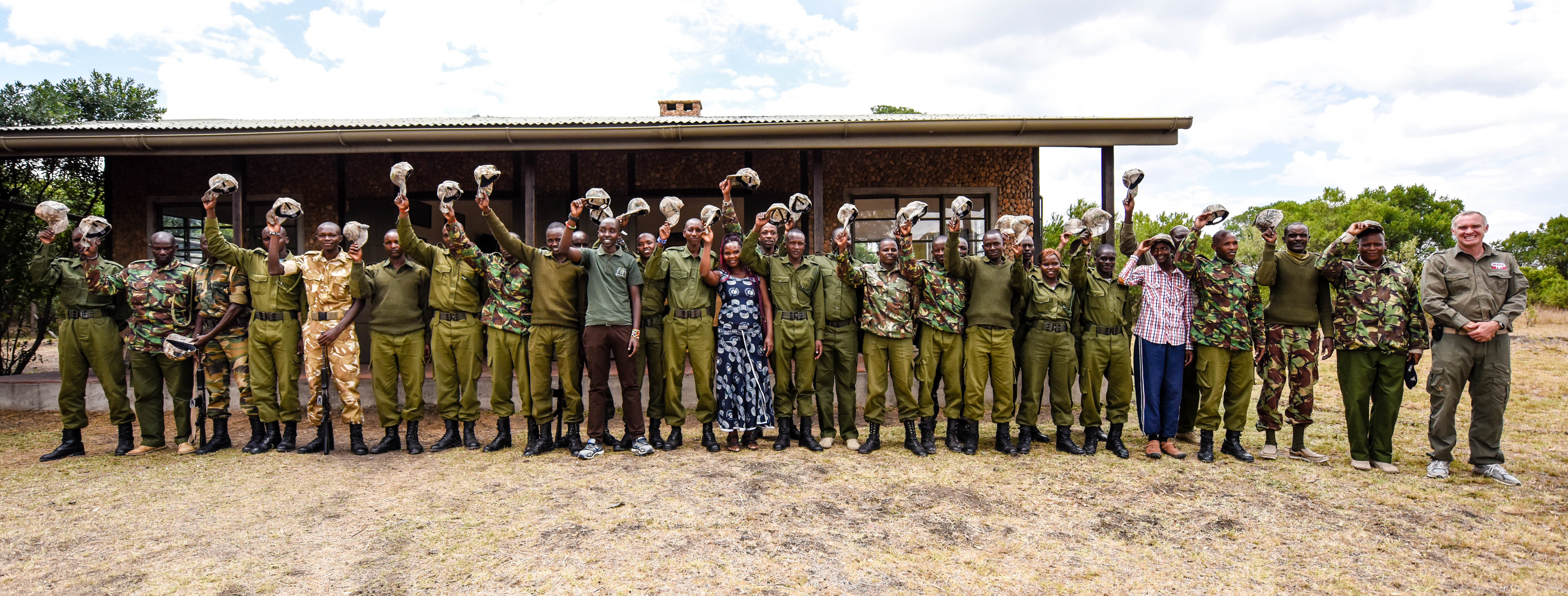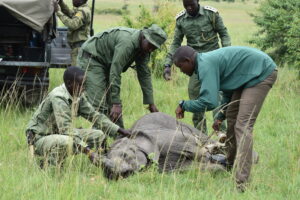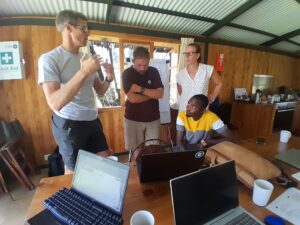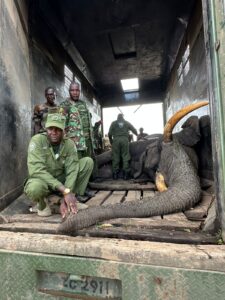We are happy to be able to present to you the Mara Elephant Project 2017 Annual Report.
MEP Annual Report 2017
There are so many amazing highlights, but we’ll just mention a few.
1.) We increased our area of operation in 2017 to include the Mau Forest and Loita Hills area of the greater Mara ecosystem. These two areas in the ecosystem were seeing high levels of illegal logging, poaching and human-elephant conflict (HEC). Our reach has been able to expand without the addition of rangers through some clever scheduling. We are deploying rangers during low human-elephant conflict seasons away from their normal operational areas and into Loita and the Mau. This has allowed us to address the high level of HEC during high HEC seasons in our normal area of operation and expand into new areas.
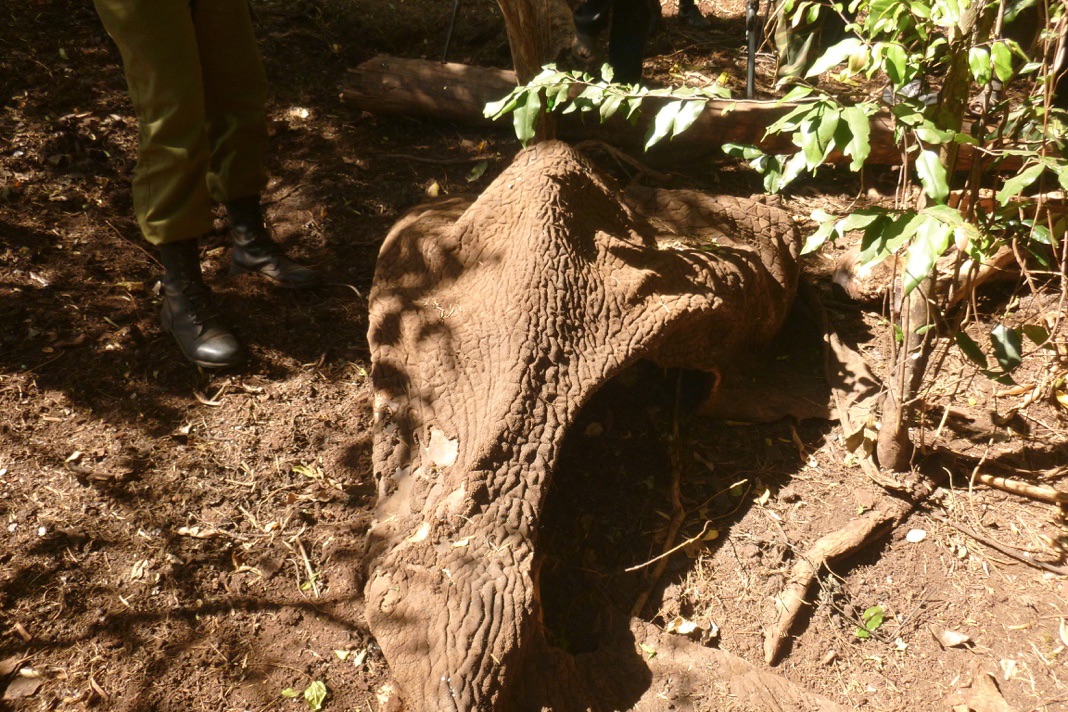
An elephant carcass found in the Loita Hills.
2.) The Mau Forest was such a major concentration of MEP’s in 2017 that it needs its own category of achievements. First, the David Sheldrick Wildlife Trust agreed in December 2017 to provide funding for a permanent ranger unit in the Mau Forest starting in January 2018. In 2017, MEP concentrated so much effort into shutting down illegal logging sites, arresting poachers, recovery ivory and mitigating human-elephant conflict in this area that a permanent team was necessary to address all of our concerns and we’re honored DSWT partnered with us to achieve more. Second, MEP collared two new elephants in the eastern portion of the Mau Forest. The male (Wilber) and female (Nancy) are the first two elephants ever to provide data on elephant movements in this area. Since their collar deployments in November, the data they’ve provided has already helped with our boots on the ground DSWT team’s movements in the forest. Third, since our reconnaissance flights in the Mau Forest began in March 2017, we’ve managed to identify over 600 elephants living in this forest and now in 2018 we’re providing on the ground permanent protection for them and building relations with the surrounding communities to mitigate human-elephant conflict.
3.) In 2017, MEP arrested 24 middlemen with 176 kg of elephant ivory in areas as far as Meru and Nairobi. In 2017, we recovered more ivory from arrested suspects than was lost in the Mara ecosystem from poaching or conflict. Though always troubling, due to MEP’s efforts, poachers only took five sets of tusks out of all of the elephant’s carcasses MEP uncovered in 2017, a total of 34. Our intelligence department continues to confirm that ivory is still being sought after by poachers and brokers and we’ve recently discovered that the bulk of the ivory recovered is coming out of Tanzania.
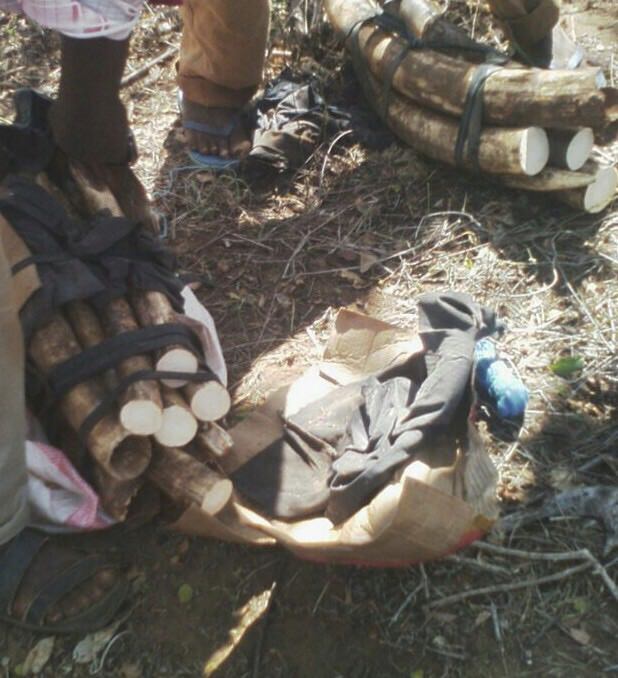
Two suspects arrested in October in Meru town by KWS rangers based on MEP intelligence with 40 kg ivory.
4.) This leads into our more permanent relationship with the Tanzania National Parks Authority (TANAPA). The Mara ecosystem is an extension of the vast Serengeti ecosystem, located in Tanzania. In 2016, MEP realized through our collared elephant data, that “our” elephants were moving in and out of Tanzania quite regularly and that in order to continue monitoring them aerially and protect them on the ground, we needed to establish a relationship with TANAPA. We’re happy to report that in January of 2017, that relationship was solidified when MEP received permission to monitor our collared elephants in the Serengeti on a monthly basis. In May, we re-collared Mytene in the Serengeti along with TANAPA and in July, using MEP intelligence, TANAPA was able to arrest three suspects and recover 46 kg of ivory and two firearms. This continues to be a key partnership for both TANAPA and MEP operations that in 2018 we are growing.

MEP supporter Karsten Ree with collared elephant Mytene.
5.) MEP is proud to report that the Percentage of Illegally Killed Elephants (PIKE) decreased from 49% in 2016 to 44% in 2017. The total number of dead elephants decreased from 47 in 2016 to 34 in 2017. While a decrease in this area is always a win for our organization, what we are seeing is an increase in the number of human-elephant conflict (HEC) situations we are responding to as an organization. We had 181 total HEC incidents in 2017 vs. 91 in 2016, 46 cases alone in the month of June, the highest ever for our organization! However, with this significant increase in responses MEP is very proud to report that our elephant deaths as a result of human-elephant conflict were down from 14 in 2016 to 11 in 2017. This means the MEP method is working to protect elephants in the Mara.
6.) In 2017, MEP replaced two elephant collars and deployed six new collars. Mytene was re-collared in the Serengeti with partners Kenya Wildlife Service, Narok County Government and TANAPA; Limo was also re-collared after his previous collar’s lifespan was up. Our new collared elephants in 2017 include: Ndorre who was collared in the Loita Hills to monitor her herd of 50 and collect important data; Hangzhou was collared in the southeastern section of the Mara Conservancy; she and her herd of 14 will give us important HEC data on the top of the escarpment; Nancy and Wilber in the Mau Forest, they are the first two elephants ever monitored in the Mau Forest and are providing essential data for this little-known area; Lempiris was collared in response to an HEC injury of a little girl that MEP responded to, he is a large bull that was being aggressive in a community; finally, Earhart, a replacement elephant in former collared elephant Santiyan’s herd.

Collaring elephant Earhart named after the famous aviator, Amelia Earhart.
7.) The Karen Blixen Camp Ree Park Safari helicopter continues to be a vital asset in MEP’s toolkit. We’ve managed to add it to our Spydertracks application to track its movements throughout the Mara. Additionally, in 2017, the helicopter was used to transport an injured little girl to the hospital. She was trampled by a male elephant and MEP was the first responder on the ground to administer medical attention. In total, MEP responded to 12 community incidents in 2017, the majority of which using one of MEP’s vehicles to provide first aid or the helicopter for evacuating people to the hospital. We also had our first pachyderm passenger in the helicopter that garnered our organization quite a bit of notoriety. A baby elephant was found starved and dehydrated, after Dr. Limo treated the baby, she was airlifted by MEP in the helicopter to the DSWT orphanage in Nairobi.
8.) We developed a habitat protection project with our partner, Mara North Conservancy, that was possible through a grant of $300,000 provided by a donor. We understand the clear linkage between better protecting the conservancies and keeping the elephants in the conservancy areas where they are safe. In order to do this, MEP has worked with the conservancies to address the threats to the habitat namely settlement and over grazing.The grant was provided to develop livestock management plans, move settlements from inside the conservancies, and better police their natural resources for elephants. This project was completed at the end 2017 and MNC reports that they have made significant headway in the management of their conservancy. Agro-forestry projects are also key to combatting habitat loss. MEP has gathered evidence which shows that elephant habitat and specifically trees are being harvested for firewood, charcoal, and building materials. As an example, the Ngoswani Primary School uses firewood-based burners to cook lunch for 400 children daily. So, MEP began working with the school to help erect an electric fence around the property to prevent human wildlife conflict and plant 400 seedlings. MEP plans to work with the school wildlife club and along with partner, Woodlands 2000 Trust, develop sustainable woodlots, which generate sustainable sources of firewood, charcoal and timber. The sustainable woodlot cycle is aimed at both providing alternative energy sources to schools but also as a learning tool for children to propagate at home.
9.) MEP’s core supporter, the ESCAPE Foundation, funded a comprehensive research study in 2017 that was completed by Well Told Story on youth attitudes toward wildlife and conservation in Kenya. This was the first research conducted of its kind in Kenya and the findings were extremely impactful. The key findings of this research are:
- The wildlife conservation industry is confusing for Kenyan youth; the relationships between conservancies, communities and wildlife are often conflicting; the ways for youth to engage and the resulting rewards for doing so are not obvious; this results in youth feeling detached and disengaged
- Young people have varied levels of awareness about wildlife and conservation; depending on their levels of awareness, youth vary drastically in their attitudes and beliefs about what constitutes conservation efforts, who the stakeholders are and their roles, what constitutes poaching, etc.; youth who have exposure to wildlife as well as academic knowledge about wildlife are more likely to be motivated to engage in conservation efforts
- There appear to be four segments of youth determined by their proximity to conservation zones and level of exposure to wildlife; two of the segments are highly motivated to contribute to wildlife conservation – one may be interested in direct engagement and the other one in advocacy and fundraising efforts; the other two segments do not see a benefit to being involved
- Engaging young people requires a well-planned strategy, targeting each segment with individual relevant messages and rewards in terms of emotional, social or financial capital offered in exchange for interest and engagement
The research’s findings were used to produce a film, MABINGWA, that is available on MEP’s website. We will continue to collaborate with the ESCAPE Foundation and local partners in 2018 as they seek to catalyze a new conversation in Kenya about conservation and will incorporate the findings into the work we do in local communities and schools.
10.) Last but not least, all of these achievements could not have been possible without the support of passionate individuals, organizations and foundations! Thank you for supporting Mara Elephant Project and we look forward to keeping you up to date on our progress in 2018 through our communication channels: MEP Blog: Elephant Matters, MEP Facebook and MEP Instagram.
